Starting a pig farm or piggery is a good decision you’ve made or you’re about to make. No doubt, pig farming is a profitable and low-cost enterprise. However, intending pig farmers like you would need to have basic knowledge about pigs and pig farming business. You should know things like:
- Systems of keeping pigs
- Housing of pigs (How to build pig house)
- Breeding of pigs
- Pig Nutrition
Terminologies in Pig or Swine Production
- Boar: An adult male pig
- Sow: An adult female pig that has given birth at least once
- In-sow: A pregnant female pig
- Barrow: A male pig castrated before reaching sexual maturity
- Gilt: A young female pig that has never given birth
- Piglet: A very young pig that is between 1-30 days old
- Weaner: A very young pig that has been removed from the mother
- Runt: A weak or small pig in a litter
- Wallowing: The act of taking a bath in a water-filled container or depression
Also Read: Facts about Pig Farming Business
Pig Production Systems
There are three ways pigs can be raised or kept. Similar to poultry, cattle and other livestock animals, pigs can be raised under:
- Extensive or Free-range system
- Semi-intensive system
- Intensive system
Extensive or Free-range system
This is a system in which the pigs are allowed to move around without limits or unconfined. The animals find and scavenge for food themselves while the farmer supplements this with agricultural byproducts or kitchen waste. In the evening, the pigs return to the enclosure made for them as shelter. This enclosure is usually a small place made of sticks and a simple roof.
In this type of management system of pig, local pig breeds are usually kept and bred because they have high resistance to diseases and can manage with low-quality food/feed. One of the advantages of this extensive system is that little, or no money is spent in providing food or veterinary services for the pigs.
Under the extensive or free-range system, the pigs are allowed to mate indiscriminately, giving room for inbreeding. Hence, the reason for poor-quality and poorly performing offspring. The quality of pigs is usually a priority to the farmers since the pigs are not kept or bred as a regular source of income or meat production. The pigs are sold when the keeper needs extra cash or they are present as gifts during festive seasons.
Semi-Intensive System
A Semi-intensive system involves confining the pigs to limited space or area. The keeper provides all the feed, water and veterinary services that the animals need because they are not allowed to scavenge or find food and water for themselves. So the pigs are feed with kitchen wastes and agricultural byproducts such as corn husks and cobs, cassava peels, yam peels, etc.
Under this type of management system, the pigs are allowed to graze on grasses within the confined space. The pregnant sows are usually given special attention and provided with extra food.
Unlike in the extensive system, farmers keeping pigs under a semi-intensive system spends more time and effort on the pigs. The financial inputs are fairly low but more technical knowledge about pig production is required.
Intensive System
The intensive system is the best and recommended system of keeping pigs if the production goal is to generate income. Under this system, pigs are kept indoors or in pens and not allowed to move outside. The pens are constructed in such a way that the pigs can eat and drink in their pen. This is the type of management system practiced by commercial pig farms. If you want to start a pig farm, then you must choose this system to get the best from the animals.
How to Construct a Pig House or Pen
Before going fully into how to construct a pig house, it is important to list the advantages of keeping pigs indoor or in a house. These include:
- The animals will be able to conserve energy because they won’t scavenge for food.
- They get maximum protection from rain and sun.
- High piglet survival and very low mortality rate.
- Good hygiene and health management are easier.
- Feeding routines can be more carefully controlled and adjusted for different classes of pigs.
- Heat control, weaning and other management practices can be done appropriately and timely.
- It makes record keeping easier.
- Manure can be collected quickly and easier for biogas production.
It is worth mentioning that the merits listed above will only work if standards are maintained. Undoubtedly, it is easy for infectious diseases to spread quickly when many pigs are kept together in a small pen or space. Hence, hygiene and sanitation must be of high priority. Additionally, the living condition of a pig house must be excellent in order to make the animals perform excellently.
Also Read: How to Build a Pig Pen or House
Ideal Climatic Conditions for Pigs
The climate (especially temperature) to which pigs are exposed is of great importance. Pigs are very sensitive to any changes in ambient temperature. They can neither withstand draught or heavy rainfall. They are not a friend of intense sunlight because it makes their skin dry out.
Temperate must be considered when building a house of pigs. The house should be constructed in such a way that temperatures in the day are low and the animals are kept warm in night or during cool periods.
A healthy adult pig should have a body temperature that ranges between 38oC and 39oC. The normal body temperature of piglets is between 39-40oC. Anything above 40oC is a sign of illness.
When the body temperature of a pig is high, they consume less feed or food and this affects growth and reproductive performances. Because pigs generally lack a sweat gland, they can’t sweat in order to cool their body. Therefore, a pig farmer should ensure the temperature in the pig house is below 35oC.
The following are the ideal temperatures for pigs (of different ages) for optimum feed conversion and growth.
- 1 day old piglets — 35°C
- 1 day-1week old piglets — 30°C
- 1-6 weeks old piglets — 24-30°C
- Pigs from 20-60kg — 20-26°C
- Pigs from 60-90 kg — 18-22°C
- Adult Pigs 18-22°C
Requirements for a Good Pig House
The climate and number of pigs to be kept determine how pig houses and pens are constructed. Before choosing where the pig houses will be constructed and what materials to use, the local conditions of the area must be considered. Know whether the area is waterlogged, noisy, exposed to wind, etc.
If the area is damp, hot or humid, shade and breeze should be taken into consideration. The pig house in this kind of area should be open and airy. The walls of the pens should be low and allow free passage of air for good ventilation.
Other important conditions that the proposed pen for a pig must meet include:
- The pen must not be free of draught
- Rain and sunlight should not have access into the pen
- The ambient temperature shouldn’t vary much
- The pen must be easy to clean
- The floor of the pen must be non-slippery and sloping
- It should allow easy management of pigs
- There should be provision for collecting and storing litter, manure and waste water for future use.
Siting of a Pig House
You must choose your pig farm site carefully when you want to build your pig house.
Hints:
- If you’re in a hot region, ensure that the house is constructed in an east-west orientation. It is advised to have a few trees on the site. Trees can serve as shade and they can help in screening and absorbing heat.
- The site must be blessed with enough water supplies so that the pigs can have access to clean water for drinking, wallowing and for cleaning purpose.
The Roof
The roof should be constructed using a roofing material that insulates excellently against cold and heat, and it should be durable. If there are no alternatives, you can use corrugated aluminum or iron sheets, but ensure that trees are surrounding the pens.
The roof must be sloppy. Depending on the design, the longest slope should be facing the prevailing rain and wind direction. Nevertheless, the recommended orientation of the roof is east to west.
You can also build something similar to the picture below. It is called an open roof ridge. This particular design helps pig farmers to reduce the temperature.
The Floors and Bedding
When constructing the floor of the pen, ensure that the floor is slightly elevated above the surroundings. It should also have a slight slope in order to prevent flooding of the pen with wastewater and easy run-off. The recommended slope is 3 cm/m.
A drain should be built so that faecal manure and wastewater can be collected easily into a sewage pit. This faecal manure can be used as an organic fertilizer or to produce methane gas (biogas).
The floor should be concreted, hard but not too smooth to make floor cleaning easy. Don’t use woods to make the floors as it woods can rot quickly and the pigs can chew them up. In fact, woods can be so slippery and harbor pathogens, microbes or parasites.
The floor should be at least 10cm thick and the sand, stones and cement ratio should be 2:3:1; that is 2 parts of sand, 3 parts of stones and 1 part of cement should be mixed together. As earlier mentioned, the concrete should not be so rough to discourage the pigs from scratching their body on it. Nevertheless, a too smooth concrete floor must be avoided so that the pigs won’t get injured due to slipping. In case you have a too smooth floor, spread some quantities of soil on the floor surface.
The Walls
How the walls of a pig house should be constructed depends on the climate of the area. In countries in the tropics like Nigeria, the walls of a pig house should be low and left opened so as to give room for adequate ventilation. A wall height of about 1.2 metres is recommended while the distance between the wall and the roof should be 1 metres. The 1.2 metres is recommended as it is high enough for any pig to climb over and also adequate to protect the pigs from strong winds and rain. The space between the wall and the roof can be covered with wire netting. This wood lining will prevent the pig from digging into the mud wall. Bamboo poles or boards can also be used to construct the wall.
Brick and cement walls are stronger and last longer even though they are costlier. Cement and brick walls are easy to clean and maintained, and they make a pig house look great.
The feed trough should be inside the pen and can be made of cement, wood or iron. Ensure that the feed trough is long enough for all the pigs in the pen to feed on it all at once. Fatteners need a feeding space of 30 cm each while sows need a feeding space of 40 – 50 cm each. You can also use self-feeder for a group of 10 pigs.
The water trough shouldn’t be so wide else the pigs will bathe in the trough. You can prevent this by fixing an iron bar across the water trough.
Avoid keeping pigs of different sizes or ages in the same pen. The stronger ones may bully or bite the weaker pigs when there is inadequate feed to eat. So the stronger pigs get fatter while the weaker pigs get leaner.
Also, install showers or sprinklers in all the pens to cool down the pigs when the temperature is high. If these are not provided, the pigs will urinate and defecate in their resting places in order to cool down their body.
Size of Pig Pens and Runs
I will like to reiterate here that pigs are one of the cleanest animals in the world. They hate drinking dirty water, defaecating where they feed or urinating in the feeding area. The reason why some pigs demonstrate some dirty, unhealthy habits is because the space of their pen is inadequate. If there is run (dung area) in a pig pen, the pigs will always go outside to defaecate. You should also ensure that the main pain (covered area) is not too big.
Pigs need a clean feeding area with a water and feeding trough; a resting area with adequate ventilation; and excreting area (run) where they will always excrete. If these three areas are available in the pen, you will see the pigs exhibiting hygienic behavior naturally.
- A 2 x 2.5 m pen can accommodate a sow with her piglets. The run of this pen should not be less than 1.5 x 2 m.
- A 2 x 2 m pen can accommodate 8 – 10 weaners.
- A 3 x 3 m pen can accommodate 10 fatteners (depending on their weight and size at slaughter). Each fattener should have a space of 1 m2.
- A 2 x 2.5 m pen is ideal for two sows while a 2.5 x 2.5 m pen is suitable for three sows.
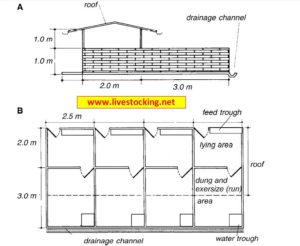
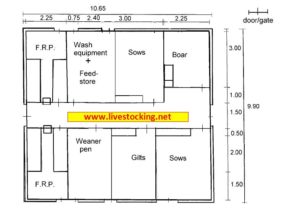
Pig Breeding and Reproduction
Recommended Breeds of Pig to Start a Pig Farm
After constructing the pig house and putting all necessary infrastructures in place, the next thing to do is deciding on the breeds and number of pigs to keep in the house. This is a very important stage because the decision you make will determine the profit level of your pig farming venture.
There are many breeds of pigs. We have local breeds and exotic breeds. If you’re going on a commercial scale, keeping exotic breeds of pigs is recommended. Read this post on the recommended pig breeds for commercial pig farming. The following are the recommended exotic breeds:
- Large White
- Landrace
- Duroc
- Poland China
- Tamworth
- Yorkshire
- Hampshire
- Crosses of the above
Considerations When Selecting Boars and Sows for Breeding
The following should be considered before you choose or select your boars or sows.
- The boars and sows should have a minimum of 12 normal nipples and teats respectively, 6 on each side.
- They should be the healthiest and biggest in their group.
- They should possess strong legs and be able to walk well.
- Their parents should have excellent performance records, such as good-sized litters, good feed conversion and excellent mothering ability.
- They should not be inbred. This means they should be from different sources.
How to Manage the Boar
A young, healthy boar is matured for mating when he is 9 – 10 months old. Make sure that the first sow the boar will serve is not bigger than the boar. You should also avoid overusing a boar for mating. Overworking a boar is detrimental to his health and productivity.
Normally, a healthy boar can serve between 10 – 20 sows. Cull your breeding boar after 3 years and replace it with another good boar. Don’t allow a boar to service or mate his own daughters as doing this will result in inbreeding.
You should care for the boars by feeding them and allow them to do many exercises. Boars should not be too lean or too fat. When a boar is ill, allow him to rest for 4 – 8 weeks and let another boar take over the servicing task until the main boar is fit. Don’t keep boars together with sows to disallow indiscriminate mating or inaccurate records.
How to Manage the Sow
Sows shouldn’t be allowed to grow fat. When this happens, the affected sows will have leg and fertility problems. Allow all sows to get plenty of exercise in order to stay fit, burn out excess fat and develop their legs well.
Normally, young sows (gilts) are mature to conceive at 6 months of age, but servicing them at this age is not advised. They should be allowed to attain good weight before they are serviced. So wait until the gilts reach 8 – 10 months before they could be serviced. If gilts are serviced too early, there will be poor growth, small litters, farrowing (birth) problems and loss of conditions.
Few weeks before servicing gilts or sows, they should be well-fed with protein-rich food or feed and extra quantities of feed should be provided. These make them fit and strong for mating, and allow the animals to produce more eggs for fertilization.
The gestation period of pigs is 3 months, 3 weeks and 3 days. Most pigs farrow after 114 – 115 days.
How to Know When a Sow is in Heat (Oestrus)
The following are the signs of heat (oestrus) in female pigs:
- Swelling and redness of the vulva which is more evident in gilts than sows.
- Mucous discharge from the vulva
- Mounting of other sows in the pen
- Sows in heat often don’t finish their feed
- Production of a special grunting noise
Click here to read more about detecting heat (oestrus)
Management of Piglets
After newborn piglets are born, soak the navel of each piglet in an iodine solution to prevent inflammation (omphalitis). The piglets should also be aided by putting them onto the udder of their mother. They need to suck from the colostrum (first milk) which helps in fighting impending diseases.
Young piglets tend to be anaemic (have a shortage of iron in their blood) because there is less iron in the sow’s milk, and wouldn’t meet the iron needs of the piglets. Piglets suffering from anaemia become pale and their growth rate drops. You can prevent anaemia by putting clean compost or iron-rich soil (red, yellow or brown soil) in the corner of the pen every day. When the piglets eat some of the soil, they will be able to supplement the iron-deficient in their mother’s milk. You can also give the piglets iron injection (Iron D) at the age of 1 – 3 days.
Some important operations carried out on piglets are:
- Teeth trimming
- Castration
- Weaning
Teeth Trimming
The creep teeth of piglets should be trimmed or removed as they can use these teeth to injure each other or damage the teats of their mother. A drill, hand file or hand plier can be used to remove these creep teeth. You can as well ignore this operation if the piglets are calm and litter is not more than ten (10) piglets.
Castration
To prevent the meat of male pigs from tainting by an unpleasant smell, they have to be castrated. Castration also helps in increasing feed conversion to meat (pork). Castration should be done when the two testes have descended into the scrotum.
Ensure that the animal is healthy and fit before carrying out the operation. If not, postpone the castration. One person can castrate a piglet—the handler will hold the piglet between his knees. Nevertheless, if there are two people, one person can assist in holding the piglet while the other person performs the castration. The piglet should be held upside-down while the hind legs are pulled towards the belly of the piglet.
How to castrate a piglet
- Wash the scrotum and wipe it with an antiseptic.
- Position one of the testicles- against the skin and make an incision, large enough to permit the testis- to come out easily.
- Cut the spermatic cord attached to the testis- using a very shape blade or knife that has been disinfected.
- Wash the wound with disinfectant and inject the piglet with oxytetracycline and multivitamins. Click here to read more about Castration
Weaning
Weaning is the process of separating a piglet from the mother in order to be able to feed and survive without dependence on the mother. Piglets should be weaned between 4 – 8 weeks old of age. After they are weaned, they should be placed on a creep feed diet. Creep feed is very rich in protein and low in fiber. Whenever piglets are to be weaned, the sow or mother should be removed from the piglets and not the piglets from the sow.
Pig Nutrition
in pig farming, nutrition is very vital. Pigs can consume everything that humans eat. They are omnivores; that is, they can feed on food from both vegetable and animal origins. For pigs to perform better, they need to be fed balanced diets and in adequate quantities.
Pigs can eat kitchen wastes, edible vegetables, farm by-products such as cassava peelings, yam peelings, maize cobs, etc. Nevertheless, they perform much better on concentrates. The following are good formulae for different classes of pigs.
Sample Pig Starter or Creep Feed Formula
| Ingredient | Quantity (KG) |
|---|---|
| Maize | 550 |
| Groundnut Cake (GNC) | 140 |
| Brewers Dry Grains (BDG) | 133 |
| Soybean Meal (SBM) | 90 |
| Fish meal | 50 |
| Bone meal | 31 |
| Salt | 2.5 |
| Methionine | 1 |
| Pig Premix | 2.5 |
| Total | 1000 |
Sample Pig Grower Feed Formula
| Ingredient | Quantity (KG) |
|---|---|
| Maize | 250 |
| Groundnut Cake (GNC) | 80 |
| Cassava peels | 100 |
| Brewers Dry Grains (BDG) | 150 |
| Wheat Offal | 274 |
| Soybean Meal (SBM) | 50 |
| Palm Kernel Cake (PKC) | 62 |
| Bone meal | 28 |
| Salt | 2.5 |
| Methionine | 1 |
| Pig Premix | 2.5 |
| Total | 1000 |
Sample Pig Fattener Feed Formula
| Ingredient | Quantity (KG) |
|---|---|
| Maize | 220 |
| Groundnut Cake (GNC) | 30 |
| Cassava peels | 100 |
| Brewers Dry Grains (BDG) | 130 |
| Wheat Offal | 274 |
| Maize Bran | 50 |
| Soybean Meal (SBM) | 20 |
| Palm Kernel Cake (PKC) | 150 |
| Bone meal | 20 |
| Salt | 2.5 |
| Methionine | 1 |
| Pig Premix | 2.5 |
| Total | 1000 |
Sample Pig Breeder Feed Formula
| Ingredient | Quantity (KG) |
|---|---|
| Maize | 200 |
| Groundnut Cake (GNC) | 30 |
| Cassava peels | 100 |
| Brewers Dry Grains (BDG) | 150 |
| Wheat Offal | 299 |
| Maize bran | 15 |
| Soybean Meal (SBM) | 50 |
| Palm Kernel Cake (PKC) | 120 |
| Bone meal | 30 |
| Salt | 2.5 |
| Methionine | 1 |
| Pig Premix | 2.5 |
| Total | 1000 |
Feed Efficiency and FCR
Pigs produce more live weight gain from a given quantity of feed than any other class of meat animals. Pigs are capable of producing 100kg weight gain from 300 – 350 kg of feed; that is 1 kg of pork can be produced from 3 – 3.5 kg of feed.
Feed Conversion Ratio (FCR) is the total quantity of feed utilized to realize the growth or increase in body weight.
The formula used to calculate Feed conversion ratio (FCR) is:
For example, if a pig consumed 120 kg feed to attain a weight gain of 60 kg. The FCR is:
You can only calculate FCR if the animals are fed with dry feed. A lower FCR shows a better feed efficiency. Also, an FCR that is lower than 3 is very good while an FCR higher than 4 is not good.
Factors that affect Feed Conversion Ratio (FCR)
These include:
- Age
- Quality of feed and feeding system
- Exposure to extreme weathers
- Genetic variation
- State of health
If pigs are not fed with adequate quantities of feed for maximum growth, they will first use the feed to fulfill their body maintenance needs before using the rest for growth.
Pigs should be served enough water in order to eat well, cool down the body temperature and prevent death due to thirstiness.
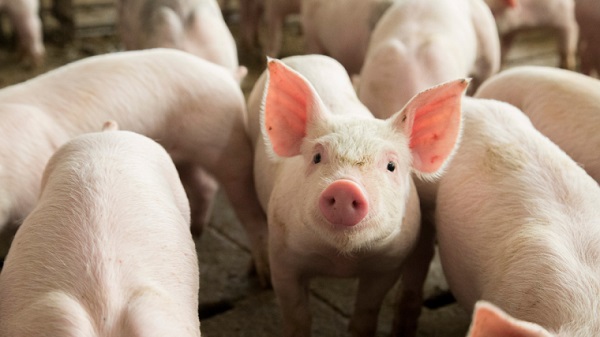
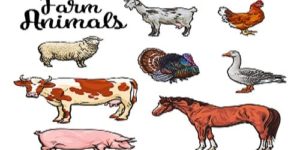
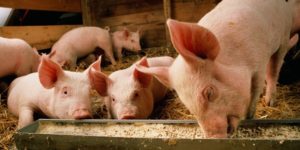
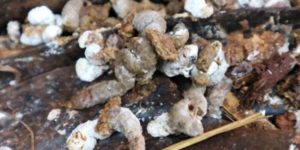
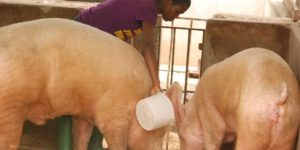
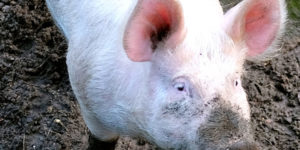
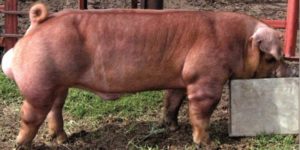

Sir
I am very much interested in starting a free range pigs farming in my area, I will to start it with 50 females pigs and 5 males at a go, as such, I am looking an acre of land which I think is good for a start, as a specialist what do you think, having that, I am very please with your lecture on free range pig farming. please, get in touch with me through my email below.
Free-range piggery is good. At least, the capital is low. But based on your comment, it seems you are referring to semi-intensive farming. If you are using an acre of land, then you will need to fence the land. You will also have to build a house for the pigs. Have a pasture with many edible vegetables and plants, which should be supplemented with concentrates.
Hi
I would like to appreciate the good work you are doing to enlighten farmers .
It’s quite helpful
I’m a dairy farmer .I’ve been thinking of doing my own formulation for the dairy meal .
Kindly guide on getting a nice formula
You are very much right
Helo sir am a student and ave alwys dream of rearing animal like pig. Please hw much wil i need 2 rear a boar and a sow. The housing is readily made making use of school farm
Well, with #60,000-80,000 (depending on breed and weight) you can get a mature bow and sow. However, you can get a pure pig breed at a cheap price. They are always expensive. For example, a pure Duroc weaner can cost you as high as #80,000 in Nigeria. So imagine what an adult pig will cost. Advisably, get mixed breeds and start production.
I want to start with duroc pig like how many of it do I need
You can start with 5 gilts and one mature boar.
Am very much impressed with the lecture, I am now in love with pig farming. Am confused about the pattern of the roof shown above, it seem some part of the pen was not covered by the roof. How can I source for the large white pig? Is it better to start with the piglets or the gilts? I am also confused about the provision of showers? U made mention of the tempt being less than 35C , do u mean room tempt or the body tempt? How can I measure the room tempt? The blocks for the wall, is a solid or hollow blocks? Is it wise to breed pig and fish in the same vicinity?
Thanks Okolie. Yes, the part not covered is the excreting and playing area.
-You can get large white pig breed in big farms across Nigeria. Nevertheless, you can contact me.
-It’s recommended to start with gilts.
-The shower is meant for cooling
-Room temperature and you can use a thermometer to take the measurement
-Solid blocks are preferable
-You can breed both together, however, proper waste disposal must be done.
Thanks my dear for the answers. Kindly call me with this number 08037468869 or mail me vitusokolie@yahoo.com or better still send u r contact so that we can start business. Thanks
Am very much impressed with the lecture, I am now in love with pig farming. Am confused about the pattern of the roof shown above, it seem some part of the pen was not covered by the roof. How can I source for the large white pig? Is it better to start with the piglets or the gilts? I am also confused about the provision of showers? U made mention of the tempt being less than 35C , do u mean room tempt or the body tempt? How can I measure the room tempt? The blocks for the wall, is a solid or hollow blocks? Is it wise to breed pig and fish in the same vicinity?
. Trelleck done sir. Very good lecture. Am a farmer. Is it better to start with piglets or the gilts?
Your questions have been answered. Thank you
Sir am so much inlove with your lecture so far
Good morning Mr. AKIN, KINDLY HELP ME SELECT GOOD BREEDS OF PIG FOR BREEDING.
THANKS IN ADVANCE
Good morning,I like your write up.kindy advise me on how to get pure breeds of large white and duroc.I want to start this piggery business.what about the innoculated deep litter in piggery which is very popular in Asia and recently the United States?You didn’t make mention of it.
This Article was very helpful. Thank you Akinbobola A.
I am about starting, getting a good breed is my major concern.
Hi. Send me a message through this link to discuss this further http://www.livestocking.net/contact
Hello Akin,
Very good presentation.
How do I source good breeds to start up?
Thanks, Chinedu. You can get good breeds at any Livestock research farms in Nigeria.
Hi… I’m from indonesia. Glad to find this web
Compliment sir, I love that and I will like to know more about this breed and piggery at all.
Good day sir,
How will it cost me to start a pig farm with 8 Gilt of different exotic breeds 2 male weaners of white and duroc for crossing the female ones?
The cost of feeding, Housing and maintenance for an average of 6 months in a low key formate
Thank
Your page it’s so straight and soooooo helpful. Thanks for your contribution I appreciate you.
Thanks for the feedback
Please how can I get a pure breed of Duroc and large white with a certificate for clear evidence?
Can i Durac bref in uganda?